Bus frequency as a "cycle of service" and rethinking underutilized buses + upcoming hearings
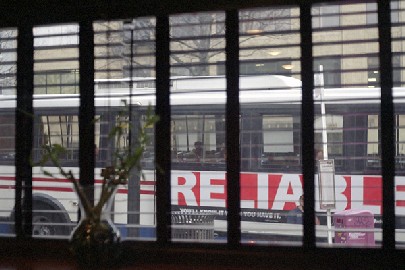 Metrobus photo by Furcafe.
Metrobus photo by Furcafe.Steve Eldridge's Sprawl and Crawl column in yesterday's Examiner, as well as a post in DC Watch, have reminded me about something that I tend to forget when thinking about "efficiency" in the provision of transit services. The point is you can't just think about individual bus trips, you also have to think about the cycle of the route and the connections to other routes, and you have to think about how the customer plans trips and for contingencies.
From the column:
Bus frequency
Ben is president of a group called Action Committee for Transit, and he generally takes me to task when I say we need roads as well as transit. He wrote recently to say: “[A recent] column points out an important part of bus service that government number-crunchers often mess up.
Bus routes don’t work well unless there is frequent service that continues well into the evening hours. The bus is not a reliable means of commuting unless you can count on another bus coming along if you miss your bus or work late. Too often, budgeters try to save money by cutting out the last bus on a route because it doesn’t carry enough passengers. But everyone riding the earlier buses on the route need that last bus as a safety valve, so when you cut the last bus, you lose ridership on the earlier ones.
Ride On made this mistake in the early ’90s, and it took 10 years to fix. Now most Ride On routes run well into the evening, and Montgomery County has a fixed rule that if a bus runs at all, it runs at least once every 30 minutes. Unfortunately, Fairfax and Prince George’s counties still have far too many bus routes that shut down in early evening, or run only once an hour.”
Sheila Willet wrote more specifically about this in a DC Watch entry entitled "Metro Closes Doors," which she graciously has allowed me to reprint. I don't necessarily agree with all her points (e.g., the X6 service to the National Arboretum is woefully underused, with frequently the buses being 100% empty), but if I only paid attention to what I thought, I wouldn't learn very much... She writes (slightly edited):
The slogan “Metro Opens Doors” is changing to “Metro Closes Doors” as public hearings on the proposal to eliminate Metrobus service and routes in DC, Maryland, and Virginia.
Metrobus service is not “just transportation.” For those of us without cars: 1) it makes possible gainful employment within the Washington Metropolitan Region; 2) it enriches our lives with accessibility to movies, sporting events, theaters, schools, libraries, etc.; and 3) it is essential to maintain our social contacts with friends and relatives who do not live within walking distance to a Metrorail Station. These routes were originally established because a need existed. If ridership has fallen, I think WMATA should do some advertising to increase ridership instead of penalizing the existing ridership by stopping the service.
(This last sentence is an especially good point although I would say that it is "marketing" as opposed to "advertising" that is needed. Much of the WMATA advertising is directed to what you might call "image development," and isn't focused on building ridership on specific lines. For the subway that might make sense, because it is near capacity with the current configuration--adding cars, reconfiguring subway car seating, and improving technology will allow for more passengers and more trains)
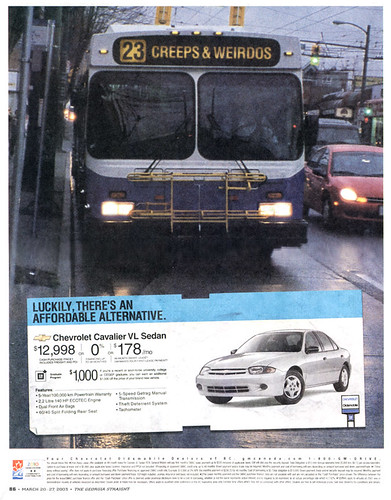 Common perceptions of bus riders. This controversial ad ran in a Vancouver, BC alternative newspaper. It was withdrawn after the outcry from transit activists.
Common perceptions of bus riders. This controversial ad ran in a Vancouver, BC alternative newspaper. It was withdrawn after the outcry from transit activists.WMATA proposes to eliminate weekend Metrobus service on two routes, weekday service on five routes, and specific late night trips on fourteen routes in the District, as well as to eliminate routes within Maryland and Virginia. For those who do not use Metrobus to travel, the bus route numbers listed in the hearing notice are meaningless. Yet to those who depend on public transportation and use these routes, the routes may be essential to their daily lives for employment or for leisure. Furthermore, since we travel throughout the whole metropolitan region, the elimination of Maryland or Virginia routes are important to DC residents also. The full public notice is online.
To highlight a few routes in the District, weekend travel on route X6 from Union Station to the National Arboretum should not be eliminated. Not only DC residents but out-of-town visitors without cars will lose convenient access to the Arboretum on weekends. WMATA proposes to add the Arboretum to two existing routes. This will extend the ride time on those existing routes with no central pick up location like Union Station to accommodate out of town visitors. On another weekend route, I envision the students from UDC and American University who utilize the “cross library privileges” might be concerned about the elimination of N8 Van Ness to Wesley Heights Loop.
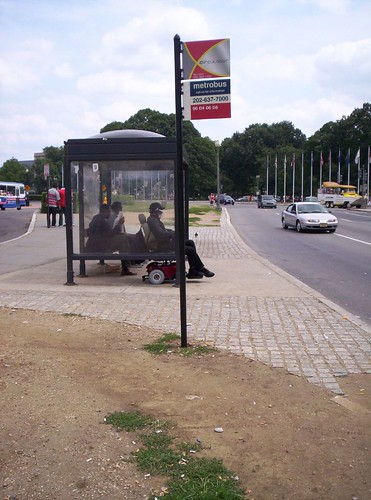 Unattractive bus stop at Union Station.
Unattractive bus stop at Union Station.Elimination of weekday service is of concern also. I believe in shopping in DC; but occasionally I want to shop at Tyson’s Corner. The 5B route is a 38-minute ride to and from Tyson’s Corner from L’Enfant Plaza station. WMATA says there are alternative Metrobus routes available. These routes begin at the Ballston-MU, Roslyn, and West Falls Church stations. To use one of these routes would extend the ride time substantially.
Other essential weekday routes WMATA proposes to eliminate include the H5, H7 Mt. Pleasant-Adams-Morgan Line and the M2 Fairfax Village to Naylor Road Station line. As to eliminating "selected late night trips," the H2, H4 crosstown line service includes two universities (CUA and UDC) as well as the VA Medical Center, Washington Hospital Center, Children’s National Medical Center. I think of those employed in the evening at these locations who use public transportation to get home after work. What options are available to them if their bus route is eliminated? Do they wait an additional hour or so? Or will they be forced to seek other employment.
I urge you to take the time to view the routes yourself. Don’t let these proposals go unnoticed. Let WMATA know that Metrobus service is important to our daily lives and should not be eliminated. Attend the public hearing or send an E-mail. Reference Docket Number B06-2 in an E-mail or letter. You can also write a letter to be received by close of business on Monday, April 17, to the Office of the Secretary, Washington Metropolitan Area Transit Authority, 600 Fifth Street, NW, Washington, DC 20001.
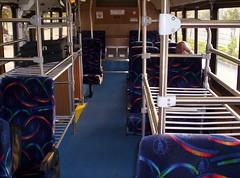 Interior of B30 Bus to BWI Airport.
Interior of B30 Bus to BWI Airport.The hearing schedule is below (and I will add it to the calendar later this evening)
7 pm, Monday, April 10
Takoma Park Middle School Cafeteria
7611 Piney Branch RoadSilver Spring, MD
7 pm, Tuesday, April 11
Metro Headquarters
600 Fifth Street, NW
Washington, DC 20001
(Gallery Place Metro Station, Judiciary Sq Metro Station)
7 pm, Tuesday, April 25
Arlington County Board Office
2100 Clarendon Blvd. 3rd Fl, Room 302
Arlington, VA (Courthouse Metro station)
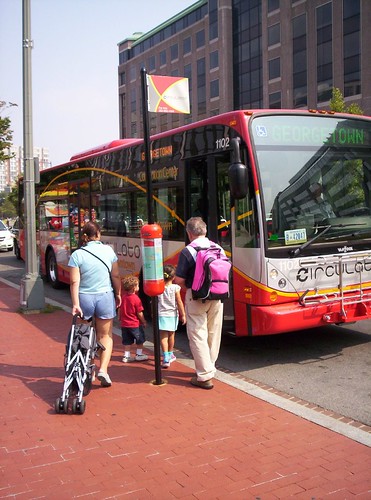 The Downtown Circulator offers a model for upgrading bus transportation in terms of marketing and quality of service.
The Downtown Circulator offers a model for upgrading bus transportation in terms of marketing and quality of service.Index Keywords: transit



0 Comments:
Post a Comment
<< Home